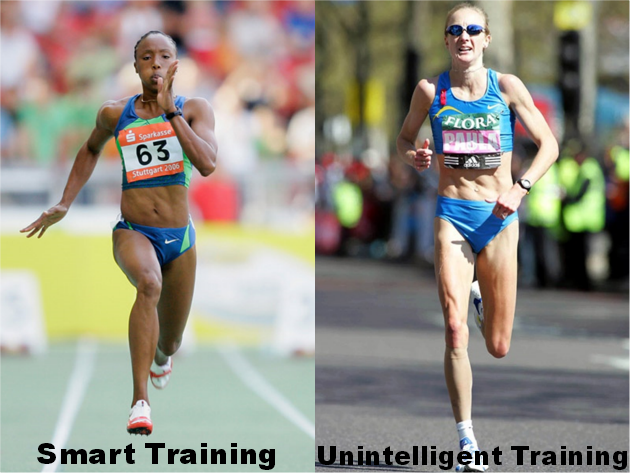 CrossFit training was initially associated with the military, law enforcement personnel and firefighters – preparing them for the unknown and unknowable.
CrossFit training was initially associated with the military, law enforcement personnel and firefighters – preparing them for the unknown and unknowable.
As of late, its popularity with the mainstream has soared giving John and Jane Q. Public the ability to face everyday life with confidence. But what if your sport is somewhat specialized– you have a goal to run a half marathon, marathon, compete in a triathlon or distance cycling race. Is this the right program for you?
I may attempt to share wisdom and ask you why would you want to do that but I will not allow my strength bias to not guide you in the best direction. Such was the case when a long time client/friend of my mine–Michelle finally confessed (after it was all over FB) that she was going to run the New York City marathon for her 40th birthday.
But why I asked – you have come so far; you’re dead lifting twice your bodyweight, you have weighted pull ups and an awesome tight and muscular body–why would you want to do that to yourself? She was determined and asked me to design her training program. Realizing there was no talking her out of it, I wanted to have her do it right with the least amount of trauma to her body.
The traditional marathoner mentality that long, slow distance gets the job done is becoming a thing of the past. And let’s face the facts – the majority of distance runners are generally weak with burned out joints. They have little power–most cannot jump onto a 12” box let alone do push ups and pull ups. Many are suffering from chronic overuse injuries (plantar fasciitis, IT syndrome, runner’s knee etc) and they spend an excessive number of hours each week on their training.
Combining CrossFit with endurance focuses more on technique and strength work and less on traditional obsessive long-distance training. I don’t care how far or how often you run; running slow will never help you get fast. Intensity is the largest determining factor. This program will only take 6 — 8 hours a week and the results have been nothing short of phenomenal.
A simplified explanation of including CF training with endurance boils down to a few basic things. . .
- Skill: work on basic motor skills for your sport
- Improve running mechanics/efficiency and/or swimming and cycling techniques
- Strength train 2x a week for Max Effort (1 -3 reps) and 1x a week for Dynamic Effort (2-3 reps at 50 — 70% of your 1 rm with maximal speed (controlled) every 45 — 90s for 10-12 “sets”)
- Add in metabolic conditioning < 10 mins on your ME days and >10 min on your DE days
- If single sport run 3x a week: short intervals (400 m and less), long intervals (800 m and > than) and a long run on the weekend or 3rd day (rarely if ever greater than 12 miles)
- If multi sport (triathlon) swimming/cycling would be included in a similar format
You can see a sample program by CrossFit Endurance’s Brian McKenzie here http://running.competitor.com/files/2011/05/12-Week-CFE-Advanced-Training-Plan-master1.pdf
Why is there no long, slow distance (LSD) in the program? “Long slow distance” is solely aerobic in nature. While it will increase cardiovascular function, better fat utilization, greater capillarization and increase mitochondrial growth it also has several drawbacks. Such as decreased strength and muscle mass, decreased power, speed, anaerobic capacity and testosterone levels. Not to mention it is very time consuming. It is obvious the drawbacks overpower the limited benefits.
The anaerobic/sprint/speed work has the following benefits and drawbacks. Benefits include increased cardiovascular function, decreased body fat, increased muscle mass, strength, power and speed and increased anaerobic capacity. The drawback is intensity can speed up overtraining so strict attention must be paid to recovery. The stamina replaces the LSD or aerobic training. The adaptations caused by anaerobic training are similar to the traditional high volume endurance training but at much lower training volumes.
Isn’t this specificity–the very thing CF is not supposed to do? Yes to a degree it is but I view it as taking a great program (CrossFit) for General Physical Preparedness and adapting it to a more specific goal. It’s shifting the emphasis to the endurance aspect without negating or ignoring strength, power and speed. What we end up with is a winning combination for those seeking to train for a distance event to the best of their abilities without losing other aspects of fitness and avoiding overuse injuries.
About the Author
Paula Jager CSCS and Level 1 CrossFit and CF Nutrition Certified is the owner of CrossFit Jaguar.
Her exercise and nutrition programs yield life changing results








The “unintelligent” training example is the current long-standing WR holder in the marathon! I guarantee she does not only do LSD running, nor does any serious distance runner. Crossfit is excellent for what it does best – makes people better at Crossfit. A good marathon program makes people better at the marathon. Crossfit only annoys people because they claim to be the answer for performance in all sports, and that just is not the case. Own your niche, let the experts in other areas own theirs.
You compare a sprinter with a distance runner. I’m a male,distance runner, 5’9 /135lb BMI (1,75m/61 kg) = BMI 20. It is ideal for distance running to be a lightweight .
For strength, I employ fast bursts and abs/lower back exercises.
Hilarious how you claim that Paula Radcliffe follows the “Unintelligent Training” program, who by the way is the WORLD RECORD HOLDER in the marathon. She would destroy any Xfit athlete (male or female) in a distance race. Nobody runs 5:10/mi for 26.2 miles doing only short sprints and weightlifting.